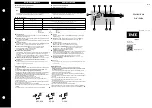
Sometimes, the mechanical power from a prime mover may decrease so much that it
does not cover bearing losses and ventilation losses. Then, the synchronous generator
becomes a synchronous motor and starts to take electric power from the rest of the
power system. This operating state, where individual synchronous machines operate
as motors, implies no risk for the machine itself. If the generator under consideration
is very large and if it consumes lots of electric power, it may be desirable to disconnect
it to ease the task for the rest of the power system.
Often, the motoring condition may imply that the turbine is in a very dangerous state.
The task of the reverse power protection is to protect the turbine and not to protect the
generator itself.
Steam turbines easily become overheated if the steam flow becomes too low or if the
steam ceases to flow through the turbine. Therefore, turbo-generators should have
reverse power protection. There are several contingencies that may cause reverse
power: break of a main steam pipe, damage to one or more blades in the steam turbine
or inadvertent closing of the main stop valves. In the last case, it is highly desirable to
have a reliable reverse power protection. It may prevent damage to an otherwise
undamaged plant.
During the routine shutdown of many thermal power units, the reverse power
protection gives the tripping impulse to the generator breaker (the unit breaker). By
doing so, one prevents the disconnection of the unit before the mechanical power has
become zero. Earlier disconnection would cause an acceleration of the turbine
generator at all routine shutdowns. This should have caused overspeed and high
centrifugal stresses.
When the steam ceases to flow through a turbine, the cooling of the turbine blades will
disappear. Now, it is not possible to remove all heat generated by the windage losses.
Instead, the heat will increase the temperature in the steam turbine and especially of
the blades. When a steam turbine rotates without steam supply, the electric power
consumption will be about 2% of rated power. Even if the turbine rotates in vacuum,
it will soon become overheated and damaged. The turbine overheats within minutes if
the turbine loses the vacuum.
The critical time to overheating of a steam turbine varies from about 0.5 to 30 minutes
depending on the type of turbine. A high-pressure turbine with small and thin blades
will become overheated more easily than a low-pressure turbine with long and heavy
blades. The conditions vary from turbine to turbine and it is necessary to ask the
turbine manufacturer in each case.
Power to the power plant auxiliaries may come from a station service transformer
connected to the primary side of the step-up transformer. Power may also come from
a start-up service transformer connected to the external network. One has to design the
reverse power protection so that it can detect reverse power independent of the flow
of power to the power plant auxiliaries.
Hydro turbines tolerate reverse power much better than steam turbines do. Only
Kaplan turbine and bulb turbines may suffer from reverse power. There is a risk that
Section 9
1MRK 502 071-UEN -
Current protection
382
Generator protection REG670 2.2 IEC and Injection equipment REX060, REX061, REX062
Application manual
Содержание Relion REG670
Страница 1: ...RELION 670 SERIES Generator protection REG670 Version 2 2 IEC Application manual...
Страница 2: ......
Страница 108: ...102...
Страница 132: ...126...
Страница 324: ...318...
Страница 442: ...436...
Страница 476: ...470...
Страница 628: ...622...
Страница 718: ...712...
Страница 728: ...722...
Страница 768: ...762...
Страница 778: ...772...
Страница 779: ...773...
















































